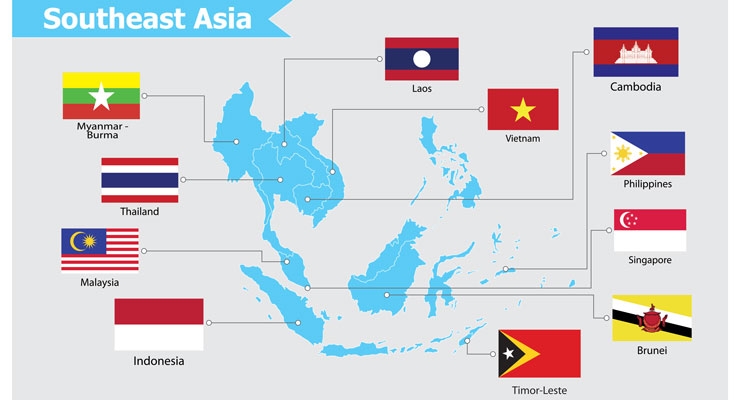
Nonwoven capacity and production demand (in-region demand and exports) in Southeast Asia is expected to continue to grow during 2016–2020, albeit at a slower pace than during prior periods. Demand growth during 2016 – 2020 is expected to average 5.5-6% per year as compared to 8-10% growth during 2010–2015. Rising market penetration, somewhat weaker economic conditions and increased capacity in export markets will weigh on demand growth. Nevertheless, demand growth will continue to be quite attractive, driven by still low market penetration for both disposable and durable nonwovens in Southeast Asia and in Asia-Pacific and Chinese export markets. The largest market for converted nonwoven products will be in hygiene end uses followed by nonwovens used in durable geotextile and related end use markets.
In 2017, nonwovens capacity in the region consists largely of spunbonded/spunmelt fine denier technology followed by carded staple fiber needlepunched and/or thermal bonded capacity and spunbonded polypropylene needlepunched technology. Small installations of other nonwoven technologies are also present.
From 2010-2015, the installation of fine denier spunbonded and spunmelt polypropylene nameplate capacity in Southeast Asia grew an average of 14.9% annually from 92,000 tons to 184,000 tons. Based upon already completed and announced expansions, the nameplate capacity of this technology will grow 6.7% per year during 2015–2020 to 254,000 tons. Additional capacity installations may occur. Medium denier spunbonded polypropylene nameplate capacity has remained unchanged since 2010 at 9000 tons.
The nameplate capacity of both fine and coarse denier spunbonded/spunmelt polypropylene technology in the region is expected to grow from 193,000 tons in 2015 to 263,000 tons in 2018 based upon expansions already announced or underway. This 70,000 tons of new capacity is equal to an annual growth rate of 10.8%. The total spunmelt polypropylene capacity in the region in 2018 of 263,000 tons will account for just 6% of total global capacity at that time.
In Malaysia, there is now 79,000 tons or 35% of the total capacity in Southeast Asia. The remaining 32,000 tons of capacity of these technologies is in Indonesia where 32,000 tons or 14% of the area’s total is present.
Based upon capacity expansions, which are already underway, total fine denier spunbonded/spunmelt and medium denier spunbonded polypropylene nameplate capacity in Southeast Asia will rise to 263,000 tons in 2020. Of that amount, 114,000 tons or 43% of the region’s capacity will be present in Thailand, 97,000 tons or 37% in Malaysia and 52,000 tons or 20% in Indonesia.
The largest producers of nonwovens in Southeast Asia all utilize fine denier polypropylene spunbonded/spunmelt technology only and focus supply to the hygiene market. Fibertex in Malaysia is the largest nonwovens producer in Southeast Asia. We estimate that Fibertex’s nameplate capacity in 2016 is 70,000 tons and will be 88,000 tons by the beginning of 2018. Based upon our estimates and assuming no additional capacity expansions are announced, Fibertex will have a 35% share of of all nameplate fine denier spunbonded/spunmelt capacity in Southeast Asia in 2020.
Asahi and CNC in Thailand have near equal capacity in 2016 at about 40,000 tons. Both companies have completed recent expansions and have not announced additional expansions at this time although it is possible that they may do so. Mitsui (Thailand) and Toray (Indonesia) both have 30,000 tons of fine denier spunmelt capacity in 2016. Toray’s capacity will increase to 40,000 tons in 2017. Mitsui is not likely to expand in Southeast Asia before 2020 as they have announced a new line installation in Japan which will be operational in mid-year 2018.
Ten Cate is the only producer of medium denier spunbonded polypropylene nonwovens in Southeast Asia. These nonwovens are needlepunched and supply the geotextile market and other related end uses. Ten Cate’s annual nameplate capacity is 9,000 tons and is unchanged since 1996.
Spunbonded/spunmelt fine denier producers in Southeast Asia will remain heavily dependent upon exports to achieve acceptable levels of capacity utilization. New capacity commissioned from 2015 to 2018 will add to that dependence. Disposable nonwoven demand is growing but remains quite small compared to installed capacity in the region. Cultural and economic barriers are still present in the region which over time is expected to change allowing for increased market penetration of disposable hygiene products.
In 2016, there is a total of 225,000 tons of fine denier spunbonded/spunmelt and medium denier spunbonded polypropylene nameplate capacity in Southeast Asia. The largest concentration of this capacity is in Thailand where 51% or 114,000 tons of all spunbonded nonwoven capacity is now present.
David J. Price is the author of the Price Hanna Consultants LLC annual subscription report “Spunbonded and Spunmelt Nonwoven Polypropylene World Capacities, Supply/Demand and Manufacturing Economics. The most recent report was published in August 2016 covering the period 2010, 2015 - 2020. To obtain a detailed prospectus for this study, please contact Michele Scannapieco, Price Hanna Consultants LLC, at mscannapieco@pricehanna.com.
Air Jordan VI High













